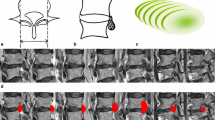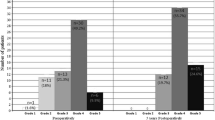Abstract
Using serial MRI, we studied 32 patients with herniated lumbar discs, treated conservatively, to clarify the natural history of this condition. MRI was performed in the acute stage, then 6 months and 1 year later. On axial images, the proportion of the cross-sectional area of the spinal canal occupied by the herniated disc was 31.9% on the average on the initial scan, 28.7% 6 months and 25.3% 1 year later. The size of the herniation decreased by more than 20% in 11 patients (34%), by 10–20 % in 8 (28%) and was unchaged in 12 (38%). The height of the disc slightly decreased with time, but there was no significant change in the angle of lordosis in the affected segment. The initial MRI revealed degeneration of all affected discs, and progressive degeneration was observed in 9 patients. The more degenerate the disc and the larger the initial herniation the more the size of the herniated fragment decreased.
Similar content being viewed by others
References
Pearce J, Moll JMH (1967) Conservative treatment and natural history of acute lumbar disc lesions. J Neurol Neurosurg Psychiatry 30:13–17
Saal JA, Saal JS (1989) Nonoperative treatment of herniated lumbar intervertebral disc with radiculopathy. Spine 14:431–437
Weber H (1983) Lumbar disc herniation: a controlled, prospective study with ten years of observation. Spine 8: 131–140
Hasue M, Fujiwara M, (1979) Epidemiologic and clinical studies of longterm prognosis of low-back pain and sciatica. Spine 4:150–155
Teplick JG, Haskin ME, (1985) Spontaneous regression of herniated nucleus pulposus. AJNR 6:331–335
Delauche-Cavallier MC, Budet C, Laredo JD, Debie B, Wybier M, Dorfman H, Ballner I (1992) Lumbar disc herniation: computed tomography scan after conservative treatment of nerve root compression. Spine 17:927–933
Bush K, Cowan N, Katz DE, Gishen P (1992) The natural history of sciatica associated with disc pathology: a prospective study with clinical and independent radiologic follow-up. Spine 17:1205–1212
Köhler D, Langer M, Schultz U, Weiss T, Stabler A (1989) Klinische und computertomographische Verlaufskontrollen konservativ behandelter Diskusvorfälle. Röntgen 42:346–351
Fagerlund MKJ, Thelander U, Friberg S (1990) Size of lumbar disc hernias measured using computed tomography and related to sciatic symptoms. Acta Radiol 31:555–558
Guinto FC, Hashim H, Stumer M (1984) CT demonstration of disk regression after conservative therapy AJNR 5:632–633
Saal JA, Saal JS, Herzog RJ (1990) The natural history of lumbar intervertebral disc extrusions treated nonoperatively Spine 15:683–686
Bozzao A, Gallucci M, Masciocchi G, Aprile I, Barile A, Passariello R (1992) Lumbar disc herniation: MR imaging assessment of natural history in patients treated without surgery. Radiology 185: 135–141
Japanese Orthopaedic Association (1986) Assessment of treatment for low back pain of the Japanese Orthopaedic Association. J Jpn Orthop Assoc 60: 391–394
Brandner ME (1972) Normal value of the vertebral body and intervertebral disc index in adults. Am J Roentgenol 114:411–414
Wiltse LL, Winter RB (1983) Terminology and mesurement of spondylolisthesis. J Bone Joint Surg [Am] 65: 768–772
Enzmann DR, et al (1990) Degenerative disc disease. In: Enzman DR, et al (eds) Magnetic resonance of the spine. Mosby, St. Louis, pp 473–509
Grenier N, Greselle JF, Vital JM, Kien P Baulny D, Broussin J, Senegas J, Caillé JM (1989) Normal and disrupted lumbar longitudinal ligaments: correlative MR and anatomic study. Radiology 171:197–205
Lindblom K, Hultqvist G (1950) Absorption of protruded disc tissue. J Bone Joint Surg [Am] 32:557–560
Mathews JA, Yates DHA (1969) Reduction of lumbar disk prolapse by manipulation. BMJ 3:696–697
Kato F, Mimatsu K, Kawakami N, Iwata H, Miura T (1992) Serial changes observed by magnetic resonance imaging in the intervertebral disc after chemonucleolysis. Spine 17:934–939
Kato F, Mimatsu K, Kawakami N, Miura T (1992) Changes seen on magnetic resonance imaging in the intervertebral disc space after chemonucleolysis: a hypothesis concerning regeneration of the disc after chemonucleolysis. Neuroradiology 34:267–270
Nohara Y, Brown MD, Burell JC (1991) Lymphatic drainage of epidural space in rabbits. Orthop Clin North Am 22:189–194
Author information
Authors and Affiliations
Rights and permissions
About this article
Cite this article
Matsubara, Y., Kato, F., Mimatsu, K. et al. Serial changes on MRI in lumbar disc herniations treated conservatively. Neuroradiology 37, 378–383 (1995). https://doi.org/10.1007/BF00588017
Received:
Accepted:
Issue Date:
DOI: https://doi.org/10.1007/BF00588017




